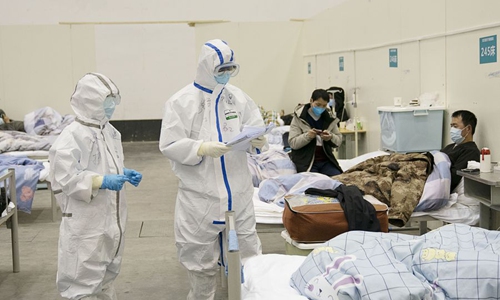‘It’s not business as usual’ – China off to slow start in resuming economic activity

Medical staff check a patient's condition at a temporary hospital converted from "Wuhan Livingroom" in Wuhan, central China's Hubei Province, Feb. 10, 2020. (Xinhua/Xiong Qi)
China’s intensifying efforts to resuscitate the economy after a near standstill for several weeks due to the outbreak of the deadly coronavirus has got off to a slow start, as many factories and businesses confront difficulties to resume operations given the tremendous risks and obstacles, despite promising signs for the epidemic outside of Hubei.While many provinces where the epidemic has subdued significantly reported that up to around 70 percent of large industrial companies have resumed operations, several other indicators predict a much grimmer picture, where some areas have only seen around 30 percent of normal production capacity, according to official and industry data.
In East China’s Shandong, a major manufacturing base, 71.5 percent of the more than 20,000 major industrial firms each with annual sales revenue of above 5 million yuan ($716,712) have resumed operations, according to local official data on Monday. Several other provinces, including East China’s Jiangsu and Fujian provinces, have also reported that more than 50 percent of major industrial firms have resumed activities.
Such numbers reflect China’s overall plan to allow State-owned enterprises (SOEs) and larger companies to take the lead in resumption of operations, according to Tian Yun, director of the China Society of Macroeconomics Research Center.
“It is much easier and more controllable for SOEs to restart operations at a time when there is still tremendous uncertainty about the epidemic,” Tian told the Global Times on Monday, adding that as the epidemic is increasingly being brought under control in the country outside of Hubei, the epicenter of the outbreak, more businesses will follow suit.
While the epidemic remains challenging in Hubei, other parts of China have shown significant drops in numbers of new infections. On Monday, the number of new cases in the other 30 provinces, municipalities and regions dropped for a 13th consecutive day to 115, according to official data.
This week, more larger private companies and foreign enterprises have resumed full operations. One of the largest carmakers in the world has called back all of its employees in Beijing, according to one employee, who spoke on condition of anonymity.
However, the situation at private and medium-sized companies remains dire, as they continue to weigh the safety and other risks and face daunting obstacles mostly stemming from the top-down efforts to combat the virus, such as necessary protective devices that company must deploy before resuming operation.
In Yiwu, East China’s Zhejiang Province, one of the nation’s manufacturing powerhouses, a vast majority of factories remain closed, while many are slowly returning to operations, according to Shi Xinyu, who runs a small company that exports manufactured products.
“There is nothing we can do about the restrictions because this is a critical time,” Shi told the Global Times on Monday, referring to restrictions local officials have put in place to combat the epidemic. “But the number of companies resuming operations is gradually picking up,” Shi said.
While there is no official data on how many businesses, including SMEs, have resumed operations, some indicators painted a gruesome picture. Official data from the Ministry of Transportation showed on Saturday that the number of passengers on the nation’s transport network since the end of the Chinese New Year Holiday has dropped more than 82.3 percent year-on-year to 238 million.
The means that only between 23 percent and 37 percent of workers have returned to work in major cities, including Beijing, Shanghai, Guangzhou and Shenzhen so far, compared to 95 percent in previous years after the Chinese New Year holiday, according to CITIC Securities.
And in terms of energy consumption, which is also a reliable indicator of economic activity, the six largest power companies only reported between 370,000 tons and 400,000 tons of daily consumption of coal, about 30 percent of consumption in normal times, CITIC Securities said in a research note.
“This is not business as usual. Companies cannot just turn on the machines and start production like they did after the Chinese New Year in previous years. There are more challenges they are facing that will take more time to overcome before returning to normal,” said Cao Heping, a professor of economics at Peking University in Beijing.

